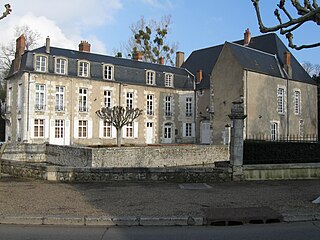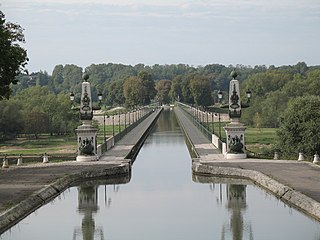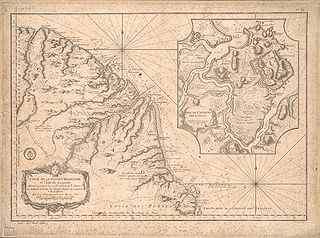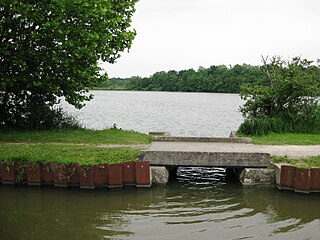Related Research Articles

Canals or artificial waterways are waterways or engineered channels built for drainage management or for conveyancing water transport vehicles. They carry free, calm surface flow under atmospheric pressure, and can be thought of as artificial rivers.
The year 1642 in science and technology involved some significant events.

The Briare Canal is one of the oldest canals in France. Its construction started in 1604. It was the first summit level canal in Europe that was built using pound locks, connecting the Rhone-Saône and Seine valleys. It is 57 kilometres long and is part of the Bourbonnais route from Saint-Mammès on the Seine to Chalon-sur-Saône on the Saône.

Briare is a commune in the Loiret department in north-central France, in the historical region of Puisaye. The composer and organist Henri Nibelle (1883–1967) was born in Briare.

Navigable aqueducts are bridge structures that carry navigable waterway canals over other rivers, valleys, railways or roads. They are primarily distinguished by their size, carrying a larger cross-section of water than most water-supply aqueducts. Roman aqueducts were used to transport water and were created in Ancient Rome. The 662-metre (2,172 ft) long steel Briare aqueduct carrying the Canal latéral à la Loire over the River Loire was built in 1896. It was ranked as the longest navigable aqueduct in the world for more than a century, until the Magdeburg Water Bridge in Germany took the title in the early 21st century.

The Canal de Garonne, formerly known as Canal latéral à la Garonne, is a French canal dating from the mid-19th century that connects Toulouse to Castets-en-Dorthe. The remainder of the route to Bordeaux uses the river Garonne. It is the continuation of the Canal du Midi which connects the Mediterranean with Toulouse.

The Briare Aqueduct in central France carries the Canal latéral à la Loire over the river Loire on its journey to the Seine. It replaced a river-level crossing from the canal to meet the Briare Canal that was hazardous in times of flood. Between 1896 and 2003 it was the longest navigable aqueduct in the world, until the opening of the Magdeburg Water Bridge.

A summit-level canal, sometimes called a "watershed canal" or just "summit Canal", is an artificial waterway connecting two separate river valleys. The term refers to a canal that rises to cross a summit then falls down the other side.

The Canal latéral à la Loire was constructed between 1827 and 1838 to connect the Canal de Briare at Briare and the Canal du Centre at Digoin, a distance of 196 kilometres (122 mi). It replaced the use of the river Loire, which was unreliable during winter floods and summer droughts. Aqueducts were used to cross the Allier at Le Guétin and the Loire at Digoin. However, because of the extreme length required, an aqueduct was not built to cross the Loire at Briare until 1896, when the Briare aqueduct was constructed.

Rogny-les-Sept-Écluses is a commune in the Yonne department in Bourgogne-Franche-Comté in north-central France. The name of the commune comes from its impressive seven locks on Briare Canal.

Châlette-sur-Loing is a commune in the Loiret department in north-central France.
Hugues Cosnier was a French engineer who conceived of the Briare Canal who was born in Tours, 1573, and died in 1629, in Paris.

The Canal du Loing is a 49.4 km long canal which connects the Seine at Saint-Mammès to the Briare Canal just north of Montargis, in central France. It runs through the Loiret and Seine-et-Marne départements.

The Portuguese conquest of French Guiana, also known as Conquest of Cayenne, was a military operation against Cayenne, capital of the South American colony of French Guiana, launched in January 1809 in the context of the Napoleonic Wars. The invasion was undertaken by a combined expeditionary force that included Portuguese and British military contingents.
The Bourbonnais route is a connection of four canals in France from Saint-Mammès on the Seine to Chalon-sur-Saône on the Saône River: It includes the Canal du Loing, Canal de Briare, Canal latéral à la Loire, and Canal du Centre.

The Canal d'Orléans connects the river Loire at Orléans to a junction with the Canal du Loing and the Canal de Briare in the village of Buges near Montargis. It is entirely within the department of Loiret.
The Canal Henri IV is a section of the Canal de Briare that connects the Loire to the remainder of the Canal de Briare in Briare. It joins the Canal de Briare at the same point as the Canal latéral à la Loire.

Étang de la Gazonne,, is a 29-hectare (72-acre) lake that provides water for the workings of the Canal de Briare.

The Loire is the longest river in France and the 171st longest in the world. With a length of 1,006 kilometres (625 mi), it drains 117,054 km2 (45,195 sq mi), more than a fifth of France's land, while its average discharge is only half that of the Rhône.

The Puisaye is a natural and historical region of France, now divided between the departments of Loiret, Nièvre and Yonne. Its historical and administrative center is the town of Saint-Fargeau. Its inhabitants are known as Poyaudins.
References
- 1 2 3 Lance Day, Ian McNeil, ed. (1996). Biographical Dictionary of the History of Technology . Routledge. ISBN 0-415-19399-0.
- ↑ Rolt, L. T. C. (1973). From Sea to Sea. Ohio University Press. ISBN 9780713904710.